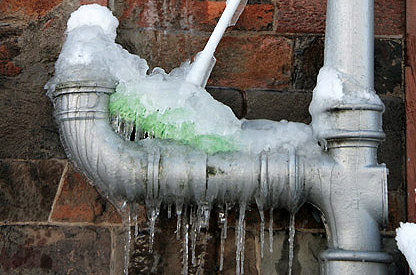Right here underneath you can discover a good deal of sensible advice pertaining to Winter Plumbing Precautions: Preventing Frozen Pipes.

Cold weather can ruin your plumbing, specifically by freezing pipes. Right here's exactly how to stop it from taking place and what to do if it does.
Introduction
As temperatures decline, the danger of icy pipes rises, potentially resulting in costly repairs and water damages. Comprehending exactly how to avoid frozen pipelines is vital for property owners in cold environments.
Prevention Tips
Insulating at risk pipelines
Cover pipes in insulation sleeves or make use of warm tape to protect them from freezing temperature levels. Concentrate on pipes in unheated or outside areas of the home.
Heating strategies
Maintain indoor rooms effectively heated, particularly areas with plumbing. Open up closet doors to enable warm air to distribute around pipelines under sinks.
Just how to identify icy pipes
Try to find reduced water flow from faucets, unusual odors or noises from pipes, and noticeable frost on revealed pipes.
Long-Term Solutions
Structural changes
Take into consideration rerouting pipes away from exterior walls or unheated areas. Add additional insulation to attic rooms, cellars, and crawl spaces.
Updating insulation
Purchase high-grade insulation for pipelines, attic rooms, and wall surfaces. Appropriate insulation helps keep regular temperatures and lowers the danger of frozen pipelines.
Securing Outdoor Pipes
Garden hoses and exterior faucets
Separate and drain pipes garden pipes before winter months. Install frost-proof faucets or cover outdoor taps with insulated caps.
Comprehending Icy Pipes
What causes pipes to ice up?
Pipelines ice up when subjected to temperatures below 32 ° F (0 ° C) for expanded durations. As water inside the pipes freezes, it broadens, taxing the pipe walls and potentially causing them to burst.
Threats and damages
Icy pipes can bring about water system disruptions, property damage, and expensive repairs. Burst pipes can flood homes and cause extensive structural damage.
Signs of Frozen Pipeline
Identifying icy pipelines early can prevent them from breaking.
What to Do If Your Pipelines Freeze
Immediate actions to take
If you suspect icy pipelines, maintain taps open to eliminate stress as the ice melts. Use a hairdryer or towels taken in hot water to thaw pipelines gradually.
Conclusion
Preventing icy pipes calls for proactive actions and quick feedbacks. By comprehending the reasons, indications, and safety nets, property owners can shield their plumbing throughout cold weather.
6 Proven Ways to Prevent Frozen Pipes and Protect Your Home
Disconnect and Drain Garden Hoses
Before winter arrives, start by disconnecting your garden hoses and draining any remaining water. Close the shut-off valves that supply outdoor hose bibs and leave the outdoor faucet open to allow any residual water to drain. For extra protection, consider using faucet covers throughout the colder months. It’s also important to drain water from any sprinkler supply lines following the manufacturer’s directions.
Insulate Exposed Pipes
Insulating your pipes is an effective way to prevent freezing. Pipe insulation is readily available at home improvement stores and is relatively inexpensive. Pay close attention to pipes in unheated areas such as the attic, basement, crawl spaces, or garage. Apply foam insulation generously to create a buffer against the cold. You can also wrap your pipes in heat tape or thermostat-controlled heat cables for added warmth.
Seal Air Leaks
Inspect your home for any cracks or openings that could let in cold air. Seal any holes around the piping in interior or exterior walls, as well as the sill plates where your home rests on its foundation. Additionally, make sure to keep your garage door closed unless you’re entering or exiting. Leaving it open creates a significant air leak that can lead to frozen pipes.
Allow Warm Air Circulation
During cold snaps, it’s essential to allow warm air to circulate evenly throughout your home. Leave interior doors ajar to promote better airflow. Open kitchen and bathroom cabinets to help distribute heat consistently around the rooms. If you have small children or pets, be sure to remove any household chemicals or potentially harmful cleaners from open cabinets for safety.
Let Faucets Drip
A small trickle of water can make a big difference in preventing ice formation inside your pipes. When temperatures drop significantly, start a drip of water from all faucets served by exposed pipes. This continuous flow helps prevent the water from freezing. Additionally, running a few faucets slightly can relieve pressure inside the pipes, reducing the chances of a rupture if the water inside does freeze.
https://choateshvac.com/6-proven-ways-to-prevent-frozen-pipes-and-protect-your-home/

Do you really like reading up on Prevent Frozen Pipes ? Create a remark directly below. We would be delighted to listen to your opinions about this review. We hope that you visit us again soon. Liked our piece of writing? Please quickly share it. Help others check it out. I appreciate your readership.
Details